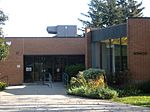St. Leo's Roman Catholic Church (Mimico)
EtobicokeRoman Catholic Archdiocese of TorontoRoman Catholic churches in OntarioRoman Catholic churches in Toronto

St. Leo's Roman Catholic Church is a Catholic church in Toronto, Ontario, Canada. It is located on Royal York Road (formerly Church Street) at Stanley, in the Mimico neighbourhood, part of Etobicoke. It is the oldest Catholic church in Etobicoke and the only Catholic church in Mimico.
Excerpt from the Wikipedia article St. Leo's Roman Catholic Church (Mimico) (License: CC BY-SA 3.0, Authors, Images).St. Leo's Roman Catholic Church (Mimico)
Royal York Road, Toronto Etobicoke
Geographical coordinates (GPS) Address External links Nearby Places Show on map
Geographical coordinates (GPS)
| Latitude | Longitude |
|---|---|
| N 43.6142 ° | E -79.4974 ° |
Address
St. Leo's Roman Catholic Church
Royal York Road 277
M8V 1P1 Toronto, Etobicoke
Ontario, Canada
Open on Google Maps










